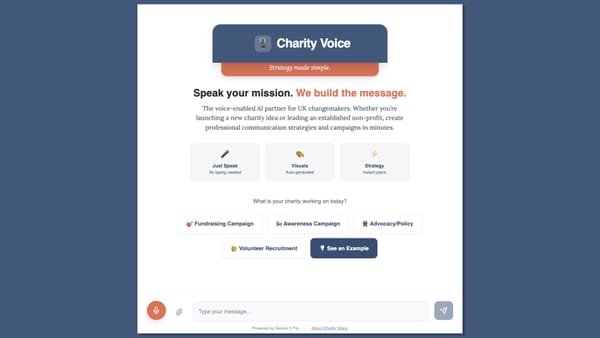Why Applied Comms AI? (And What to Expect)
I'm here to experiment, fail, learn, and share everything along the way. Think of this as your comms insider's guide to figuring out AI together.

Right, let's address the elephant in every boardroom: AI.
If you're a communications professional, you've likely sat through at least one meeting where someone's asked, "But what about ChatGPT?" or "Should we be using AI for this?"
If you're honest, you might have nodded knowingly whilst thinking "I haven't got the faintest clue" – or something along similar lines, but far more profane.
You're not alone. Last month, I ran a digital workshop for a multinational client (through my consultancy Faur), and the comms team's relationship with AI ranged from "we tried it once for a press release and it was terrible" to "we're not allowed to touch it." Sound at all familiar?
Speaking at almost the midpoint of 2025, it feels clearer than ever that AI isn't going away. However, most of what is written about it is either breathless tech evangelism or vendor marketing disguised as insight. What's missing? Honest, practical guidance from people who actually understand communications.
Why I'm Starting This
After nearly 20 years of leading digital innovation, social media strategy, community building, communications, and content at organisations including Brunswick, Red Bull, and the BBC – working with everyone from FTSE 100 CEOs to international charities – I've seen how technology can positively transform comms when applied thoughtfully. I've also seen spectacular failures when it's not.
Now, through Faur, I work with organisations like ParalympicsGB and multinational corporate market leaders on their digital transformation. And every single one is grappling with the same question: how do we make AI actually useful for communications?
I don't have all the answers. Nobody does. But I'm here and willing to experiment, fail, learn, and share everything along the way. Think of this as your comms insider's guide to figuring out AI together.
(In time, I'd like Applied Comms AI to grow into a supportive community, but let's not get ahead of ourselves – after all, becoming overwhelmed by the possibilities is often the precise problem when it comes to AI experimentation and implementation.)
What You Can Expect
In every newsletter, you'll get a mixture of sections including:
🧪 The Experiment: We'll build or test something practical. Maybe it's creating an AI tool for crisis statements, or seeing if ChatGPT can actually write a decent internal comms piece. Real experiments, real results, no sugar-coating.
🔧 Tool Test Drive: An honest review of an AI tool from a comms perspective. What it promises vs what it delivers. Whether it's worth your time (and budget).
💡 In Brief: The AI news that actually matters for comms pros, minus the hype. Plus quick wins from other readers.
✍️ Prompt of the Week: A tested, refined AI prompt you can copy and use immediately. Because sometimes you just need something that works.
Monthly features will include:
- Interviews with comms leaders who are actually using AI (not just talking about it).
- Behind-the-scenes looks at our own experiments at Faur.
- Reader case studies and community insights.
What This Isn't
This isn't another tech blog. It's not vendor marketing. It's not academic theory. And it's definitely not going to pretend AI is either the saviour or destroyer of communications.
It's pragmatic experimentation by comms professionals, for comms professionals.
Why Now?
Because we're at an inflexion point. AI tools are finally capable enough to be genuinely useful, but not so complex that you need a computer science degree to use them. The window for competitive advantage is open, but it won't stay that way.
More importantly, I'm seeing too many talented comms professionals feeling left behind by the pace of change. That's not right. We've adapted to every other technological shift – from print to digital, from broadcast to social. We'll figure this out too.
Our Ethics Policy
As signatories to the Global Alliance's Responsible AI Guiding Principles for the PR and Communication Profession, we commit to transparency first: always disclosing when content is AI-assisted and how we use it. We're also tackling AI's environmental impact by minimising unnecessary usage while we work towards better sustainability solutions. When we discover something that compromises professional standards, we won't share it, no matter how clever it seems. Read our full ethics policy.
Join the Experiment
Over the coming weeks and months, we'll explore everything from AI-powered media monitoring to automated first drafts, from sentiment analysis to crisis prediction. Some experiments may work brilliantly. Others will likely fail and be beyond atrocious. All of them will teach us something.
This is a community effort. I want to hear about your experiments, your failures, your questions. What's working in your organisation? What's not? What are you curious about but afraid to try?
Here's what I need from you:
- Forward this email to one colleague who needs to see it. Seriously, just one. Someone who's curious about AI but doesn't know where to start.
- Hit reply and tell me: what's your biggest AI challenge in comms right now? I'll address the most common ones in upcoming issues.
- Follow me on LinkedIn where I'll be sharing highlights and starting conversations. You can find an Applied Comms AI page on there, too.
Let's make AI work for communications, not the other way around. See you next week with our first proper experiment.
Best wishes,
Michael MacLennan
Founder, Applied Comms AI
Additional Notes
- Transparency notice: I used Claude for drafting assistance and Grammarly for final polish, because even former subeditors need backup.
- As this is the first newsletter, I especially appreciate any and all feedback. As a former subeditor, some critical notes are the least I deserve.
- Applied Comms AI is powered by Faur.
,




